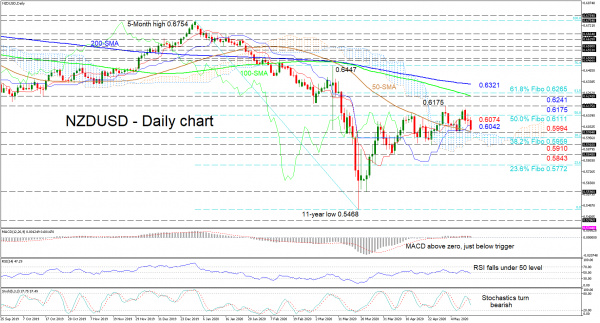NZDUSD appears to be resting at the 0.5994 support level, currently where the 50-day simple moving average (SMA) has joined with the upper band of the cloud. The flattened blue Kijun-sen line and the dropping red Tenkan-sen line suggest that positive momentum may be fading.
Turning to the short-term oscillators, they too reflect an increase in negative price action. The MACD, marginally above the zero mark, has slipped below its red signal line while the falling RSI has dipped below its neutral threshold. Furthermore, the bearish tone of the stochastic lines and all SMAs add more backing to this view.
Should sellers push down, immediate resistance could originate from the fortified 0.5994 low ahead of the 0.5959 level, that being the 38.2% Fibonacci retracement of the down leg from 0.6754 to the 11-year low of 0.5468. Diving back under the Ichimoku cloud, the 0.5910 border could halt additional declines. If sellers persist and breach the key 0.5843 trough, this could increase worries for downside moves towards the 23.6% Fibo of 0.5772 and even lower levels.
If buyers re-emerge, initial resistance could surface from the Ichimoku lines at 0.6042 and 0.6074 respectively ahead of the 50.0% Fibo of 0.6111. Moving higher, the pair may meet the 0.6175 peak before the bulls challenge the resistance region from the 0.6241 obstacle to the 61.8% Fibo of 0.6265, which encompasses the 100-day SMA, keeping in mind the 200-day SMA at 0.6321 hovering above.
Overall, the short-term bias remains bearish below the SMAs and the 0.6447 peak. However, should the price resume a positive direction above the cloud, a shift above 0.6447 may turn the picture neutral-to-bullish.













